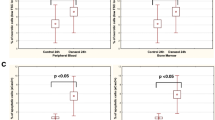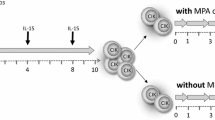Abstract
7-hydroxystaurosporine (UCN-01) is a new anticancer agentwhich exerts an inhibitory effect on cell cycle check points andis currently under phase I clinical trials in US and Japan.Preliminary clinical data indicated that UCN-01 remained inplasma at high concentrations for long periods of time. Thisunavoidable high plasma drug exposure is likely to lead tohematological toxicities in patients. In the present study,cultured human peripheral blood lymphocytes (PBLs) were used toevaluate the possible hematological toxicities of UCN-01treatment. UCN-01 induces apoptosis, and the induction ofapoptosis-related surface markers were also examined toinvestigate the involvement of these molecules in UCN-01-inducedapoptosis in PBLs. in vitroviability of PBLs wasdecreased by high dose of UCN-01 (25 μM, 3-day exposure). Thiseffect of UCN-01 was significantly suppressed by the presence ofhuman serum, suggesting that some specific inhibitory factor(s)in human serum may antagonize the lympholytic effect of UCN-01.The percentage of annexin V-positive PI-negative cells increasedwith exposure to UCN-01 in a time- and dose-dependent manner; byup to 30.3% after exposure to 25 μM UCN-01 for 3 days.At the same time, the expression of both interleukin-2 receptor(IL-2R, CD25) and Fas (CD95), analyzed by flow cytometry, wasinduced. Con A-stimulated PBLs were more sensitive toUCN-01-induced apoptosis than non-stimulated lymphocytes andUCN-01 increased the sFas-L released into culture medium from conA-stimulated PBLs. Therefore, lymphocyte depletion mediated byactivation-induced apoptosis is likely to occur in patientstreated with UCN-01 at high doses.
Similar content being viewed by others
References
Takahashi I, Kobayashi E, Asano K, Yoshida M, Nakano H; UCN-01, a selective inhibitor of protein kinase C from streptomyces. J Antibiot 40: 1782–1784, 1987
Takahashi I, Nakanishi S, Kobayashi E, Nakano H, Suzuki K, Tamaoki T: Hypericin and pseudohypericin specifically inhibit protein kinase C: possible relation to their antiretroviral activity. Biochem Biophys Res Commun 165: 1207–1212, 1989
Akiyama T, Yoshida T, Tsujita T, Shimizu M, Mizukami T, Okabe M, Akinaga S: G1 phase accumulation induced by UCN-01 is associated with dephosphorylation of Rb and CDK2 proteins as well as induction of CDK inhibitor p21/Cip1/WAF1/Sdi1 in p53-mutated human epidermoid carcinoma A431 cells. Cancer Res 57: 1495–1501, 1997
Wang Q, Worland PJ, Clark JL, Carlson BA, Sausville EA: Apoptosis in 7-hydroxystaurosporine-treated T lymphoblasts correlates with activation of cyclin-dependent kinases 1 and 2. Cell Growth Different 6: 927–936, 1995
Kawakami K, Futami H, Takahara J, Yamaguchi K: UCN-01, 7-hydroxylstaurosporine, inhibits kinase activity of cyclindependent kinases and reduces the phosphorylation of the retinoblastoma susceptibility gene product in A549 human lung cancer cell line. Biochem Biophys Res Commun 219: 778–783, 1996
Byrd JC, Rai KR, Sausville EA, Grever MR: Old and new therapies in chronic lymphocytic leukemia: now is the time for a reassessment of therapeutic goals. Sem Oncol 25: 65–74, 1998
Fuse E, Tanii H, Kurata N, Kobayashi H, Shimada Y, Tamura T, Sasaki Y, Tanigawara Y, Lush RD, Headlee D, Figg WD, Arbuck SG, Senderowicz AM, Sausville EA, Akinaga S, Kuwabara T, Kobayashi S: Unpredicted clinical pharmacology of UCN-01 caused by specific binding to human alpha1-acid glycoprotein. Cancer Res 58: 3248–3253, 1998
Tice RR, Strauss GH, Peters WP: High-dose combination alkylating agents with autologous bone-marrow support in patients with breast cancer: preliminary assessment of DNA damage in individual peripheral blood lymphocytes using the single cell gel electrophoresis assay. Mut Res 271: 101–113, 1992
Gallardo S, Cardaba B, del Pozo V, de Andres B, Cortegano I, Jurado A, Tramon P, Palomino P, Lahoz C: Study of apoptosis in human lymphocytes by toxic substances implicated in toxic oil syndrome. Toxicology 118: 71–82, 1997
Snyder CA, Valle CD: Lymphocyte proliferation assays as potential biomarkers for toxicant exposures. J Toxicol Env Health 34: 127–139, 1991
Leonard WJ, Depper JM, Robb RJ, Waldmann TA, Greene WC: Characterization of the human receptor for T-cell growth factor. Proc Nat Acad Sci USA 80: 6957–6961, 1983
Stein H, Mason DY, Gerdes J, O'Connor N, Wainscoat J, Pallesen G, Gatter K, Falini B, Delsol G, Lemke H et al.: The expression of the Hodgkin's disease associated antigen Ki-1 in reactive and neoplastic lymphoid tissue: evidence that Reed-Sternberg cells and histiocytic malignancies are derived from activated lymphoid cells. Blood 66: 848–858, 1985
Uchiyama T, Broder S, Waldmann TA: A monoclonal antibody (anti-Tac) reactive with activated and functionally mature human T cells. I. Production of anti-Tac monoclonal antibody and distribution of Tac (+) cells. J Immunol 126: 1393–1397, 1981
Itoh N, Yonehara S, Ishii A, Yonehara M, Mizushima S, Sameshima M, Hase A, Seto Y, Nagata S: The polypeptide encoded by the cDNA for human cell surface antigen Fas can mediate apoptosis. Cell 66: 233–243, 1991
Yonehara S, Ishii A, Yonehara M: A cell-killing monoclonal antibody (anti-Fas) to a cell surface antigen co-downregulated with the receptor of tumor necrosis factor. J Exp Med 169: 1747–1756, 1989
Kobayashi N, Hamamoto Y, Yamamoto N, Ishii A, Yonehara M, Yonehara S: Anti-Fas monoclonal antibody is cytocidal to human immunodeficiency virus-infected cells without augmenting viral replication. Proc Nat Acad Sci USA 87: 9620–9624, 1990
Watanabe-Fukunaga R, Brannan CI, Copeland NG, Jenkins NA, Nagata S: Lymphoproliferation disorder in mice explained by defects in Fas antigen that mediates apoptosis. Nature 356: 314–317, 1992
Fukumoto H, Nishio K, Ohta S, Hanai N, Saijo N: Reversal of adriamycin resistance with chimeric anti-ganglioside GM2 antibody. Int J Cancer 67; 676–680, 1996
Nozawa K, Kayagaki N, Tokano Y, Yagita H, Okumura K, Hasimoto H: Soluble Fas (APO-1, CD95) and soluble Fas ligand in rheumatic diseases. Arthr Rheumat 40: 1126–1129, 1997
Tanaka M, Suda T, Haze K, Nakamura N, Sato K, Kimura F, Motoyoshi K, Mizuki M, Tagawa S, Ohga S, Hatake K, Drummond AH, Nagata S: Fas ligand in human serum. Nat Med 2: 317–322, 1996
Nagata S, Golstein P: The Fas death factor. Science 267: 1449–1456, 1995
Tanaka M, Suda T, Takahashi T, Nagata S: Expression of the functional soluble form of human fas ligand in activated lymphocytes, EMBO J 14: 1129–1135, 1995
Proust JJ, Kittur DS, Buchholz MA, Nordin AA: Restricted expression of mitogen-induced high affinity IL-2 receptors in aging mice. J Immunol 141: 4209–4216, 1988
Rights and permissions
About this article
Cite this article
Fukumoto, H., Tamura, T., Kamiya, Y. et al. Activation-Induced Apoptosis of Peripheral Lymphocytes Treated with 7-Hydroxystaurosporine, UCN-01. Invest New Drugs 17, 335–341 (1999). https://doi.org/10.1023/A:1006374118879
Issue Date:
DOI: https://doi.org/10.1023/A:1006374118879




